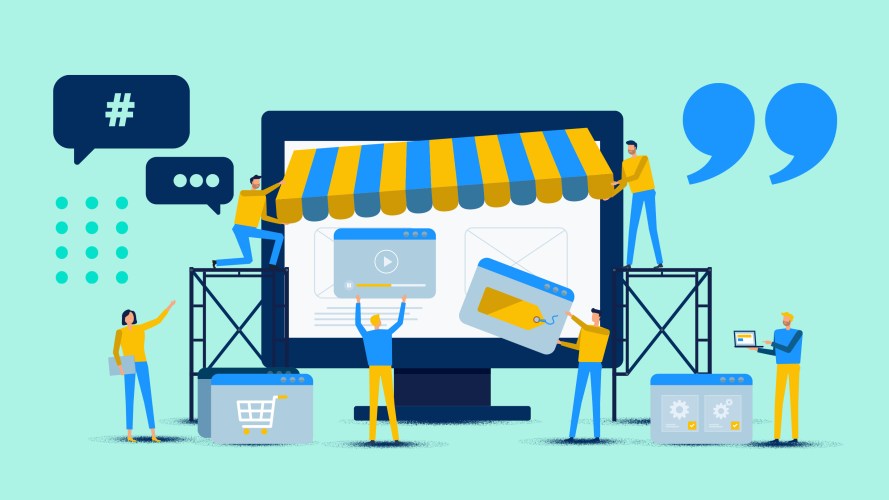At the core, buying and selling are social activities. Think about how much you depend on your digital neighbors — checking your social networks and online reviews — before you commit to buying something important. Even if it’s not a major purchase, other people’s opinions and experiences consciously and unconsciously factor into your buying decisions.
Gone are the days when sales only happened over a handshake. Today, the world moves at light speed over digital channels. Social selling lets you reach buyers everywhere, from your favorite social media accounts. Let’s explore how.
What you’ll learn:
- What is social selling?
- Why is social selling important?
- The 4 pillars of social selling
- Key tactics for selling on social media
- How to find sales opportunities with social selling tools
- Best social media platforms for sales
- Tips for engaging with prospects on social media
Engage and close prospects from everywhere
Pull up CRM data for prospects even when you’re engaging with them outside your CRM — whether on social or online.



What is social selling?
Social selling is a lead-generation technique where salespeople directly interact with their prospects on social media platforms.
Here’s an example: Mike works in sales for a human capital management (HCM) company where businesses outsource some of their HR needs to them. Browsing on LinkedIn, Mike sees a comment on a friend’s post that piques his interest. A small business leader named Monique is trying to fill open positions but is struggling to find good candidates. Since that’s Mike’s area of expertise, he seizes the opportunity to engage with Monique’s comment and share some hiring resources could consider. Mike follows up with a connection request and Monique accepts.
Monique gets the message and sees that Mike works in HCM. She’s been meaning to explore the idea of working with an HR company and puts Mike on her shortlist. When Mike sends Monique a follow up message a week later, she remembers him and sets up an appointment.
Social selling isn’t usually about snagging one-and-done deals. Instead, your social channels are prime territory for building connections with new prospects and developing business relationships.
Why is social selling important?
Social selling is important because it actually drives sales, with 78% of social sellers outselling peers who don’t use social media. This isn’t surprising when you consider that social sellers have a 51% higher chance of reaching their quotas. Whether you leverage your professional network on LinkedIn for sales prospecting or build your X following to nurture relationships in your industry, it’s a powerful tool in your sales arsenal.
As the pace of business accelerates, sales reps spend more time in front of a screen. The Salesforce State of Sales report finds that reps strive to meet rising customer expectations. Buyers want sales organizations to meet them where they are. Sellers must be flexible in reaching customers on the channels the customers prefer — whether in person, by email, or on social media.
Sales teams today can reach customers on LinkedIn, Facebook, X, Instagram, YouTube, TikTok, and more. Salesforce’s State of the Connected Consumer report found that Facebook is the most popular social media platform for brand engagement worldwide. Social networks will continue to evolve and develop because of technological advances, increasing social selling opportunities moving forward.
The 4 pillars of social selling
Social selling is built upon four key components: creating your brand, finding your buyers, engaging those buyers with relevant insights, and building lasting relationships. Each of these components is supported by the others, forming a foundation that allows you to maximize social selling. Let’s tackle them one by one:
1. Creating your brand
Start by creating a professional brand account on your chosen social platform. You can create paid ads, track metrics, and craft posts demonstrating your product’s value with case studies and thought leadership content.
Do your research before setting up an account. If your target audience isn’t on TikTok, then focus your energy on other platforms. Check out your competitors’ profiles. How are they drafting their “about me” section? Ask friends and colleagues to view your profile and provide their honest feedback about your tone and messages.
Important tip: It is necessary to distinguish your business from personal social accounts. Personal accounts are for keeping in touch with friends and family. Business accounts are for lead generation and brand awareness. How you speak to your aunt differs from how you talk to a prospect. With a business account, you can set and maintain your brand voice and keep your brand standards consistent across all digital channels.
2. Finding your buyers
Search a few of your most loyal customers and see what platforms they spend the most time on. You can then expand your search by viewing who is in their network. If you don’t have an established customer base, you can see who is following your competitor’s profiles or search for posts with trending hashtags that speak to the solutions you offer. The tools you use also play a major role. We’ll discuss those in-depth further down.
3. Engaging them with insights
Team up with your marketing department to highlight the latest blogs, reports, and thought leadership assets. You’ll want these handy when leaving a comment or messaging a prospect. Don’t just randomly chat with someone. Make sure the comment is relevant to their post and adds value to the conversion in the thread.
4. Building lasting relationships
A conversation with a prospect must be authentic. People can smell a sales pitch from a mile away. Create one-on-one relationships with people by staying in touch even when you’re not selling them anything. Like their posts, celebrate their achievements, and join their networks.
Key tactics for social selling on social media
Chances are your customers are on a social platform receiving advertisements and sales messages from your competitors. And this is only going to grow, with an expected 5.85 billion social media users by 2027. These recommendations are tried-and-true ways for sellers to successfully reach their target audience.
Be active
Social media is extremely useful for social selling — but only if you’re online and using it daily (or at least weekly) to build your connections and deepen relationships. If you haven’t logged on in a few months, it’s time to:
- Update your profile. A polished profile with a clear value proposition and relevant keywords makes a strong first impression and helps potential customers find you.
- Join key customer groups on LinkedIn. Engaging in groups frequented by your target audience allows you to listen to their needs and establish yourself as a thought leader.
- Post consistently. Regular activity keeps your profile fresh in viewers’ minds.
- Share and promote content. Sharing valuable content positions you as a helpful resource and attracts potential customers.
- Comment and engage. Interaction shows you’re interested in conversations, not just broadcasting messages. It fosters relationships and builds trust.
Be vigilant
Social media platforms offer practically unlimited information about the marketplace. You can learn what your competitors are up to, your customer’s latest challenges, and even monitor your brand’s reputation by:
- Following customers, competitors, and thought leaders. These groups keep you informed about industry trends, competitor strategies, and your target audience’s interests.
- Screening conversations and comments. Monitoring interactions allows you to address concerns promptly and participate in relevant discussions.
- Tracking your impressions and engagements. Analytics help you measure the effectiveness of your selling and identify areas for improvement.
- Setting up alerts with social listening tools. Alerts notify you of brand mentions or industry keywords, allowing you to participate in relevant conversations and connect with potential customers.
These best practices create a foundation for successful engagement. Let’s build on the foundation.
How to find sales opportunities with social selling tools
Every tool offers different features. Many tools provide detailed analytics that track impressions, engagements, and shares. Some platforms help develop content with integrated AI capabilities that suggest post copy or posting cadence. Overall, the common goal of social selling tools is to help you navigate your social environment and generate leads. This is accomplished through:
Social listening tools
Social listening is the practice of monitoring online conversations to understand what customers are saying about your brand, product, or industry. The technology tracks mentions of designated keywords, your brand, and your competitors’ brand. Some tools can even monitor post sentiment — the tone or feeling of a post.
- Use this tool to: Stay updated on trending topics, customer challenges, and how your brand is perceived so that you can develop relevant content or mitigate conflict.
- Example: You program your listening tool to track your brand’s current e-commerce solution. You see a report that features posts and comments that mention your brand’s e-commerce platform as confusing or difficult to navigate (a negative sentiment). You can proactively respond to these comments, gain user feedback, and fix any issues.
Social media prospecting tools
Certain tools use filters so that you can find customers based on industry, title, company size, and other demographics.
- Use this tool to: Navigate through profiles and networks to find the prospect that fits your ideal customer profile (ICP). You can then reach out to them with a personalized message.
- Example: You search LinkedIn for prospects that fit your ICP — customer success managers in small fintech startups with 10–100 employees. Your filters significantly narrow your search down to a few prospects. Look at what they’ve posted and craft a message that speaks to any challenges they might have referenced.
These tools are available on some of the most popular social media platforms. However, certain platforms are built to engage and sell.
Join the Salesblazer movement
We’re building the largest and most successful community of sales professionals, so you can learn, connect, and grow.

Best social media platforms for sales
A social media platform is any digital forum where people join to discuss topics, share insights, and build an online community. Some lesser-known platforms like Reddit or Quora can help you monitor what people are talking about. However, the anonymity of the respondents creates a barrier to direct outreach efforts. The best social media platforms for salespeople allow you to engage and interact with the users.
Facebook and Facebook Shop
Facebook Shop is an online storefront where people can browse products directly on Facebook. Depending on the offering, a business can use a variety of formats to promote products through the platform. Sharing brand posts is easy with the forwarding button. And buyers can save favorited items for later purchase. The shares, favorited, and saved items can be tracked for future follow-up.
Instagram and Instagram Shop
You can’t mention Facebook without Instagram because they’re both owned by Meta. Instagram and Instagram Shop provide an integrated experience that connects to Facebook. Sellers can also tap into the power of influencer marketing that promotes their brand across various creators’ accounts.
LinkedIn and LinkedIn Navigator
LinkedIn is the preferred selling tool — especially if you’re in B2B. An employee will most likely turn to LinkedIn to discuss challenges in their workplace. With the use of LinkedIn Navigator, you can pinpoint your Ideal Customer Profile (ICP) in moments and send them a direct message with InMail.
Tips for engaging with prospects on social media
I use the engage, connect, and share approach, especially on LinkedIn. It is your job to share relevant content that fits their needs. Here’s a breakdown of the process.
Meet prospects where they are
It is important to note that “engaging” is not the same as “pitching.” Pitching a prospect means you find your prospect and you start selling your product in your first communication with them. You talk about how great the company is and how your product will solve all their challenges. I call this aggressive approach “pitch slapping” and it rarely gets results.
Instead of spamming your prospect, focus on the person. The golden rule says, “Treat others how you would like to be treated.” The platinum rule says, “Treat others how they would like to be treated.” This is how you rise above the spam.
Business leaders on LinkedIn are looking for insights. I encourage sales reps to create their initial engagement with your prospect by teaching.
The first leg of my engagement strategy is to create a focused list. The list includes roughly 30 companies we want to do business with this month (they fit our ICP). I’ll find two or three individuals in that organization actively posting on LinkedIn.
The LinkedIn Sales Navigator tool takes me to posts within the last 30 days and from there, I start a conversation by commenting on that post. For example, I might find a post the prospect shared about hiring a new marketing director. I’ll leave a comment on that post saying, “Excited to hear you’re looking for new talent. Is the role remote, hybrid, or in-person?”
Connect
After I leave that comment, I’ll request a connection and say, “I saw you were hiring and left a comment on your post. I’m interested as I might have a few marketers in my network. P.S. Permission to connect here on LinkedIn.”
If your prospect accepts your connection invitation, that’s not your cue to start selling. Instead, deepen your connection by sending an email (about two days later) about the initial post you engaged with. In our example, my email subject line would say: “Thanks for the information about the job.” My email has a better chance of being opened because the prospect and I have previously engaged.
Share
Now that I have the prospect’s attention, it’s time for me to share and educate. I will still keep my message relevant to our first engagement. I’ll begin the email with, “Thanks for sharing information about the new role. Can I share it with my network? Hopefully, I can get a couple of folks who may be interested in that role.”
The second part of my email is the pitch. “A thought did come to mind. I don’t know what you’re currently using for your CRM, but as a marketing director, have you considered a CRM that can integrate and work directly with your sales folks? Just curious if I can help.”
I did something I couldn’t do in a cold call and would have been deleted and forgotten. I grabbed my prospect’s attention. I started a conversation. I engaged them and now that’s leading to a potential opportunity.
Start social selling today
Social selling has become an essential tool for salespeople. By leveraging social media platforms, you can interact directly with potential customers, build relationships, and generate leads. It’s a process that requires consistent engagement, vigilant monitoring, and a professional brand account. By following the best practices and embracing the four pillars, you can increase your chances of sales success and outperform your peers.
A new way to go from lead to close
Harness CRM data outside the CRM with Sales Engagement, and engage buyers as they move across the web.





























